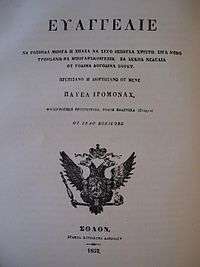Bible translations into Macedonian
Historic Translations

The history of Bible translations into Macedonian is connected in its early years with the history of Bible translations into Bulgarian. In 1852, in Salonica, the cleric Pavel Bozhigrobski printed a bilingual manuscript. It contains a Greek evangeliarium and its translation to Solun-Voden dialect from today Slavic dialects of Greece, both written in Greek letters. The texts represent the vernacular, not church language.
This translation is the oldest known text of greater scope, that directly reflects the living dialects of Aegean Macedonia of that period. Bulgarian academician Jordan Ivanov, who found the title page of the gospel in 1907, described it as written in Bulgarian dialect.[1] On the title page is written "Typed in Bulgarian language"[2] even the author himself was known later as Bulgarian Exarchate's worker.[3]
The label "Bulgarian language" for various Macedonian dialects can be seen from early vernacular texts such as the four-language dictionary of Daniel Moscopolites, the early works of Kiril Peichinovich and Yoakim Karchovski and such vernacular gospels written in the Greek alphabet. These written works influenced by or completely written in the local Slavic vernacular were registered in Macedonia in the 18th and beginning of the 19th century and their authors referred to their language as Bulgarian.[4] It is also considered by researchers from the University of Helsinki to be the oldest known Gospel translation in what would later be known as Macedonian language.
Until the winter of 2003-04 it was believed that both the manuscript and the printed text were destroyed. Only the front page was preserved and published in the book Bulgarian antiquities in Macedonia, Jordan Ivanov, 1931, p. 182., among others. Then a group of researchers from the University of Helsinki found the original manuscript of the translation of the Alexandrian Patriarch, under the reference: Bibl.Patr.Alex. 268. Another example is the Kulakian gospel from 1863, which represents translation from Greek evangeliarium to Solun-Voden dialect and was written by hand with Greek letters from Evstati Kipriadi in the town of Chalastra. On the title page is also inscription "Written in Bulgarian language".[5][6]

Official translations
In 1952 a liturgical edition of the 4 Gospels was printed. This was translated by Milošev Djordje with the help of the Macedonian Committee of the Orthodox Church. In 1957 further selections based upon the lectionary readings were published. In 1959 the Gospels of Matthew, Mark, Luke and John, translated by Georgi Milosev, Boris Boskovski and Petar Ilijevski was published by the British and Foreign Bible Society (BFBS). The first complete e New Testament translated in the Macedonian languagewas then completed and published in 1967. In 1970 the Bible Society printed an edition with cross-references following the verses. Another edition was printed in Belgrade in 1988 by the Yugoslav office of the United Bible Societies (UBS).
The whole Bible (including the Deuterocanonical books) translated in Macedonian by the Archbishop Gavril was printed in 1990. This was published by the Bible Society and it has the official sanctioon of the Macedonian Orthodox Church. The text was revised in 2006 and printed in 2 editions, one without the deuterocanonical books and one with them, which has the official sanction of the Macedonian Orthodox Church. These have been digitised by the Bible Society and the 2006 editions are now on YouVersion as MK2006[7] and MK2006D. The Bible Society launched a Macedonian Bible app which was launched in Skopje in October 2016. This is available on Android, iPhone and Google platforms.
In 2008 the Orthodox Church edited the 1952 liturgical 4 Gospels to produce a new edition used with their lectionary and liturgy.
Independent Translations
An independent translation of the complete Bible was prepared by Duško Konstantinov in the mid 1970s, but it was not printed until 1996 by the Loucas Foundation. A dynamic translation of the New Testament prepared by Ivan Grozdanov and Goran Stojanov was published in 1999 under the umbrella of Biblica.[8] Jehovah's Witnesses have translated their New World Translation of the Holy Scriptures into Macedonian.[9]
See also
References
- ↑ Български старини от Македония", Йордан Иванов, С. 1931, с. 182.
- ↑ Евангелие на Господа Бога и Спаса нашего Иисуса Христо, сига ново типосано на богарской йезик за секоа неделя от година догодина со рет. Преписано и диортосано от мене Павел йероманах, бозигропски протосингел, родом Воденска (Епархия) от село Кониково. Солон, Стампа Кирякова Дарзилен 1852.
- ↑ Български възрожденски книжовници от Македония. Избрани страници, Издателство на БАН, София, 1983, стр. 119.
- ↑ F. A. K. Yasamee "NATIONALITY IN THE BALKANS: THE CASE OF THE MACEDONIANS" in Balkans: A Mirror of the New World Order, Istanbul: EREN, 1995; pp. 121-132.
- ↑ Mazon, Andre et Andre Vaillant. L'evangeliaire de Kulakia un parler slave du Bas-Vardar, Paris 1938.
- ↑ Господново и сфетаго евангелио на бога нашаго голема црикфа христианоф, искарено на бугарцко изик тувашно збор на Вардариа за уф неделите сати за гудината и за сати празницити големите за цела година за литургиата. Са писало ут Евстатио Киприади уф селото Колакиа на 30 ноемврио месиц 1863.
- ↑ Macedonian 2006 Bible
- ↑ Macedonian New Testament - Dynamic Translation, published by the Good News Baptist Church, 1999.
- ↑ Available on-line here, in PDF format.